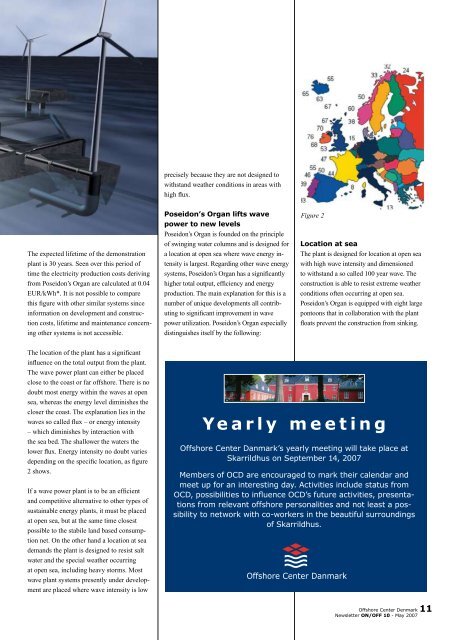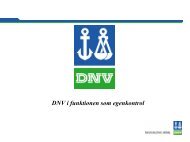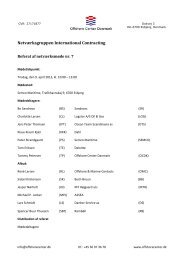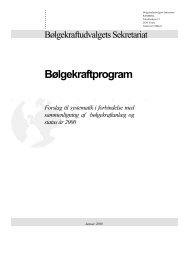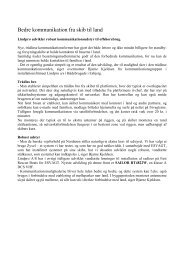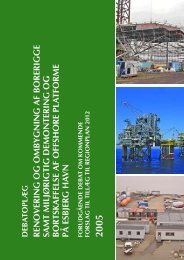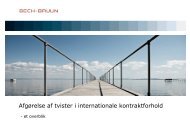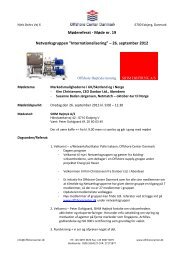Create successful ePaper yourself
Turn your PDF publications into a flip-book with our unique Google optimized e-Paper software.
The expected lifetime of the demonstration<br />
plant is 30 years. Seen over this period of<br />
time the electricity production costs deriving<br />
from Poseidon’s Organ are calculated at 0.04<br />
EUR/kWh*. It is not possible to compare<br />
this figure with other similar systems since<br />
information on development and construction<br />
costs, lifetime and maintenance concerning<br />
other systems is not accessible.<br />
The location of the plant has a significant<br />
influence on the total output from the plant.<br />
The wave power plant can either be placed<br />
close to the coast or far offshore. There is no<br />
doubt most energy within the waves at open<br />
sea, whereas the energy level diminishes the<br />
closer the coast. The explanation lies in the<br />
waves so called flux – or energy intensity<br />
– which diminishes by interaction with<br />
the sea bed. The shallower the waters the<br />
lower flux. Energy intensity no doubt varies<br />
depending on the specific location, as figure<br />
2 shows.<br />
If a wave power plant is to be an efficient<br />
and competitive alternative to other types of<br />
sustainable energy plants, it must be placed<br />
at open sea, but at the same time closest<br />
possible to the stabile land based consumption<br />
net. On the other hand a location at sea<br />
demands the plant is designed to resist salt<br />
water and the special weather occurring<br />
at open sea, including heavy storms. Most<br />
wave plant systems presently under development<br />
are placed where wave intensity is low<br />
precisely because they are not designed to<br />
withstand weather conditions in areas with<br />
high flux.<br />
Poseidon’s Organ lifts wave<br />
power to new levels<br />
Poseidon’s Organ is founded on the principle<br />
of swinging water columns and is designed for<br />
a location at open sea where wave energy intensity<br />
is largest. Regarding other wave energy<br />
systems, Poseidon’s Organ has a significantly<br />
higher total output, efficiency and energy<br />
production. The main explanation for this is a<br />
number of unique developments all contributing<br />
to significant improvement in wave<br />
power utilization. Poseidon’s Organ especially<br />
distinguishes itself by the following:<br />
Figure 2<br />
Location at sea<br />
The plant is designed for location at open sea<br />
with high wave intensity and dimensioned<br />
to withstand a so called 100 year wave. The<br />
construction is able to resist extreme weather<br />
conditions often occurring at open sea.<br />
Poseidon’s Organ is equipped with eight large<br />
pontoons that in collaboration with the plant<br />
floats prevent the construction from sinking.<br />
Ye a r l y m e e t i n g<br />
<strong>Offshore</strong> <strong>Center</strong> <strong>Danmark</strong>’s yearly meeting will take place at<br />
Skarrildhus on September 14, 2007<br />
Members of OCD are encouraged to mark their calendar and<br />
meet up for an interesting day. Activities include status from<br />
OCD, possibilities to influence OCD’s future activities, presentations<br />
from relevant offshore personalities and not least a possibility<br />
to network with co-workers in the beautiful surroundings<br />
of Skarrildhus.<br />
<strong>Offshore</strong> <strong>Center</strong> Denmark 11<br />
Newsletter <strong>ON</strong>/<strong>OFF</strong> 10 - May 2007


